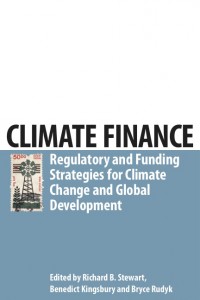Edited by Richard B. Stewart, Benedict Kingsbury and Bryce Rudyk
NYU Press (September 2009). pp 348
 |
Contents:
Full Book (PDF, 3.1 Mb) Cover (Front & Back) (PDF, 280 Kb) Front matter (PDF, 119 Kb) Section I: Climate Change and Mitigation (PDF, 641 Kb) Section II: Proposals for Climate Finance (PDF, 929 Kb) Section III: Bringing Developed and Developing Countries Together in Climate Finance Bargains (PDF, 360 Kb) Section IV: National Policies (PDF, 243 Kb) Section V Climate Finance and World Trade Organization (WTO) Law and Policy (PDF, 520 Kb) Section VI: Taxation of Carbon Markets (PDF, 247 Kb) Abbreviations and Index (PDF, 52 Kb) |
Preventing risks of severe damage from climate change not only requires deep cuts in developed country greenhouse gas emissions, but enormous amounts of public and private investment to limit emissions while promoting green growth in developing countries. While attention has focused on emissions limitations commitments and architectures, the crucial issue of what must be done to mobilize and govern the necessary financial resources has received too little consideration. In Climate Finance, a leading group of policy experts and scholars show how effective mitigation of climate change will depend on a complex mix of public funds, private investment though carbon markets, and structured incentives that leave room for developing country innovations. This requires sophisticated national and global regulation of cap-and-trade and offset markets, forest and energy policy, international development funding, international trade law, and coordinated tax policy.
Thirty-six targeted policy essays present a succinct overview of the emerging field of climate finance, defining the issues, setting the stakes, and making new and comprehensive proposals for financial, regulatory, and governance mechanisms that will enrich political and policy debate for many years to come. The complex challenges of climate finance will continue to demand fresh insights and creative approaches. The ideas in this volume mark out starting points for essential institutional and policy innovations
